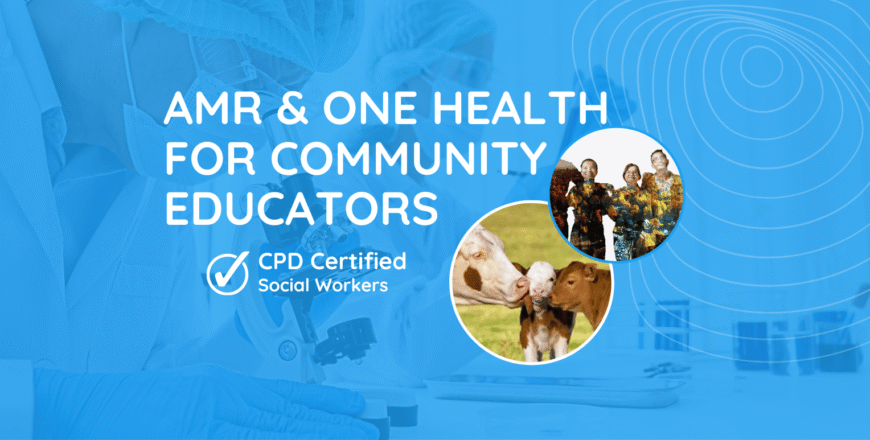This lesson introduces the global burden of antimicrobial resistance (AMR), showing how it already causes over a million deaths each year and threatens to make common infections untreatable. You will explore the current impact on health and economies, future projections if action is not taken, and the urgent need for responsible antibiotic use, infection prevention, and stronger policies worldwide.
0
0 reviews
AMR AND ONE HEALTH FOR COMMUNITY EDUCATORS
This course introduces you to antimicrobial resistance (AMR) through a One Health lens, showing how human, animal, and environmental health ...
are connected. You will learn the drivers and consequences of AMR, explore effective behavior change and communication strategies, and practice techniques to engage communities with clear and practical messages. By the end of the course, you will be able to explain AMR in simple terms, identify risky practices, and design small interventions that promote responsible use of antibiotics and protect health for future generations.
Show more
Category
552
Students
enrolled
- Description
- Curriculum
- Reviews
Antimicrobial resistance (AMR) is one of the greatest health challenges of our time. It threatens to make once-treatable infections dangerous again, increases the cost of healthcare, reduces the safety of food production, and puts both humans and animals at risk. AMR is not only a medical issue; it is a problem that touches every aspect of life, from the way we treat our families when they fall sick, to the way farmers raise animals, and to the way communities manage water, sanitation, and waste.
This course introduces you to AMR through the One Health approach, which recognizes that the health of people, animals, and the environment are closely linked. By the end of the course, you will understand how actions in one sector affect the others and why collective responsibility is essential to protect antibiotics for future generations.
As a community educator, you have a special role in this fight. People often trust you more than distant experts, which means your words and actions can directly influence how families, farmers, and leaders make choices. This course will prepare you with both knowledge and communication skills to explain clearly, guide communities, and encourage healthier behaviors that prevent AMR.
At the end of this course, you will be able to:
-
Explain clearly what AMR is and why it matters to your community
-
Identify risky behaviors in humans, animals, and the environment that drive AMR
-
Communicate practical solutions using simple language and relatable examples
-
Design small intervention projects to address AMR in your own setting
-
Serve as an advocate for the One Health approach in schools, farms, households, and local institutions
This course is delivered to you as a collaborative effort between OAZIS Health, ZIHI Institute, One Health Alliance Jordan, and Nymat Global.
Antimicrobial Resistance (AMR) in a One Health Context
-
1What is Antimicrobial Resistance?Preview 1 Hour
Welcome, this part of the course will introduce you to the world of antimicrobial resistance (AMR) in simple and practical terms, showing how everyday actions in our homes, farms, and communities can make medicines lose their power. You will discover why infections that were once easy to treat are becoming harder and more dangerous, and how this affects families, health systems, and even the future of modern medicine. Most importantly, it will highlight the vital role you, as a community educator, play in turning knowledge into action; helping people understand AMR, change risky behaviors, and protect medicines for generations to come.
-
2Basics of Microorganisms1 Hour
This lesson will introduce you to the invisible world of microorganisms, tiny living things like bacteria, viruses, fungi, and parasites that exist all around us. You will learn the difference between helpful microbes that protect us and harmful ones that cause disease, how they spread in our communities, and why understanding them is important for preventing infections and antimicrobial resistance.
-
3The basics on Antimicrobials30 Minutes
-
4The Burden of AMR30 minutes
-
5The One Health Approach1 hour
This lesson will introduce you to the One Health approach, which shows how the health of people, animals, and the environment are all connected. You will learn how misuse of antibiotics in humans, overuse in animals, and poor sanitation in the environment all contribute to antimicrobial resistance (AMR). Through real-life examples and interactive case scenarios, the lesson will help you understand why AMR cannot be solved by doctors alone, it requires farmers, communities, health workers, and environmental protection working together.
-
6One Health Case Scenarios3 questions
Drivers and Consequences of AMR Across Sectors
-
7Drivers of AMR in Human Health30 Minutes
This lesson will help you understand the main drivers of antimicrobial resistance (AMR) in human health, such as overusing antibiotics, stopping treatment too early, and self-medication. It also explains the consequences, including harder-to-treat infections, higher healthcare costs, and avoidable deaths. Through interactive discussions and examples, you will learn how responsible antibiotic use, better hygiene, and community education can protect people from the growing threat of AMR.
-
8Drivers of AMR in Animal Health30 minutes
This lesson will help you understand how the misuse and overuse of antibiotics in livestock farming contribute to antimicrobial resistance (AMR). It explains how practices such as routine drug use, growth promotion, and poor hygiene on farms create resistant bacteria in animals, making diseases harder and more costly to treat. You will also explore better ways to keep animals healthy, such as improving hygiene, using vaccines, and relying on antibiotics only when truly needed.
-
9Drivers of AMR in the Environment30 Minutes
This lesson will introduce you to how the environment plays a hidden but powerful role in antimicrobial resistance (AMR). You will learn how waste from hospitals, farms, and households can spread resistant germs through water, soil, and food, and explore simple actions communities can take to protect themselves. Through interactive examples and reflections, you will see why the One Health approach, which links people, animals, and the environment, is key to stopping the spread of AMR.
-
10QUIZ5 questions
Community Action and Risk Communication for AMR Prevention
Please, login to leave a review
Related courses

AMR AND ONE HEALTH FOR COMMUNITY EDUCATORS
Share
Course details
Duration
10 Hours
Lectures
10
Quizzes
3
Level
Intermediate
Certified
Popular courses
Archive
Working hours
| Monday | 9:30 am - 6.00 pm |
| Tuesday | 9:30 am - 6.00 pm |
| Wednesday | 9:30 am - 6.00 pm |
| Thursday | 9:30 am - 6.00 pm |
| Friday | 9:30 am - 5.00 pm |
| Saturday | Closed |
| Sunday | Closed |











